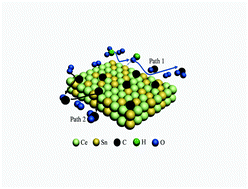A study on the catalytic oxidation of soot by Sn–Ce composite oxides: adsorbed oxygen and defect sites synergistically enhance catalytic activity†
Abstract
Herein, SnxCe1−xO2 (x = 0, 0.1, 0.2, 0.3, 0.4, 0.5, 1) catalysts have been synthesized by a co-precipitation method and their catalytic performance for soot oxidation in the presence of water is investigated. The results show that the catalyst with the optimal mole ratio (Sn : Ce = 4 : 6) exhibits the best catalytic performance, providing a T90 value of 413 °C and 92.8% CO2 selectivity. The characterization results reveal that the incorporation of Sn4+ into the lattice of CeO2 can result in the decrease of crystallite size and the improvement of Oα (the chemisorbed oxygen) and Ce3+ contents, which is beneficial for the enhancement of catalytic performance. The mesoporous structure and the increased specific surface area enhance the contact condition between the catalyst and soot. The presence of Sn converts Ce4+ to Ce3+, which increases the adsorbed oxygen content of the catalyst. The improvement of the redox activity and defective sites enhances the adsorption and activity properties of oxygen species. Moreover, repeat experiments were carried out to explore the durability.



 Please wait while we load your content...
Please wait while we load your content...